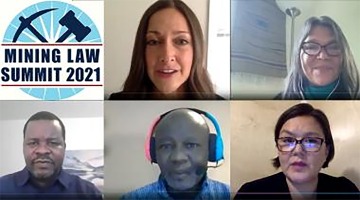Redefining Community Resistance to Mining Operations
One side of the table perceives local protests of mine development as community resistance. The other side believes they are asserting their rights. That might feel like an impasse when trying to develop a mine. What if all interests sat on the same side of the table?
It’s a growing strategy in light of seemingly opposing values addressing a common goal: Companies want to produce the minerals needed to drive the green economy, while labor unions and communities want to protect their rights and the environments that play critical roles in slowing climate change.

Community and labor advocates participated in a panel on community resistance at the 2021 Mining Law Summit
Indigenous communities in particular believe they have much to offer in this equation. They know the land and water bodies, regional weather patterns and community health conditions. They possess a sense of connection and responsibility to the land. That knowledge must be valued, says Nuskmata Jacinda Mack, executive director of Moccasin Footprint Society, a Canada-based charity. “Indigenous peoples know their homelands the best,” Mack says. “Long-term investments into indigenous grassroots systems need to be part of any discussion on further extraction or impacts to those systems.”
Mining labor activist Glen Mpufane zeroed in on the dilemma for mining workers as they fight for better safety and health conditions and just compensation for their labor. “There are no jobs on a dead planet,” said Mpufane, who directs activities regarding mining for the IndustriALL Global Union. “That illustrates the point that workers find themselves in,” he added in a panel on “Community Resistance” during the November 2021 Mining Law Summit by the University of Arizona Global Mining Law Center. “On the one hand we must fight for the protection of the planet and on the other we must ensure that the future of work is provided.”
Honest and open conversation can address other concerns, including protecting a community’s way of life, its cultural heritage sites and social practices, as well as making sure mine developers mitigate the effects of their operations and leave the community in good shape.
What it will take to find common ground
“It can be frustrating to communicate with people who don’t share similar values,” admits John C. Lacy, director of the Global Mining Law Center. “It seems that the only alternative is to have the patience to find—or try to find—common ground.” Without it, he adds, companies may have no choice but to abandon mining assets, at least for the short term.
One organization trying to find that common ground is the Initiative for Responsible Mining Assurance (IRMA). It developed the Standard for Responsible Mining, which represents the perspectives of all interests. “Directly affected communities, non-governmental organizations, organized labor, mining companies, purchasing companies and the investor and finance sector … each has an equal vote in IRMA governance, giving each sector equal power in decision-making,” says IRMA Executive Director Aimee Boulanger. [IRMA website]
Companies can use IRMA’s Mine Measure tool to assess mine site operations against the standard that covers business integrity, planning for positive legacies, social responsibility and environmental responsibility. The mine site can then undergo an independent third-party audit that results in public reports on its performance on those standards. The aim is to promote continuous improvement at the mine site.
Governments, investors and companies purchasing mined materials increasingly seek transparency on the impacts of mining. Boulanger says IRMA’s efforts help to ensure that mining decisions “don’t exclude or minimize the important perspectives, experience and objectives of communities or other stakeholders or rightsholders.” IRMA currently is working on standards for mine exploration and development, mineral processing and chain of custody.
Transparency in reporting also is a goal of mining standards under development by the Global Reporting Initiative (GRI). By the end of the year, GRI hopes to solicit public comments on a standard that companies can use to report on environmental and social impacts of their extraction sites.
The Global Mining Law Center, a collaboration of the UArizona’s James E. Rogers College of Law and the Lowell Institute for Mineral Resources, aims to address growing community interests in responsible mining. It offers nearly 20 courses addressing rights of indigenous peoples, environmental policy, social justice, transformation of culture and human rights.
These efforts could help the mining industry gain cooperation of the communities impacted by their activities. “It is important to analyze community resistance,” says Lacy of the mining law center. “Is it concern for vital elements of heritage, environmental concerns or the perception, real or imagined, that a project does not recognize community needs?”
The annual Mining Law Summit is sponsored by the Global Mining Law Center, part of the UArizona James. E. Rogers College of Law, and the Lowell Institute for Mineral Resources.
More on the Mining Law Summit 2021

